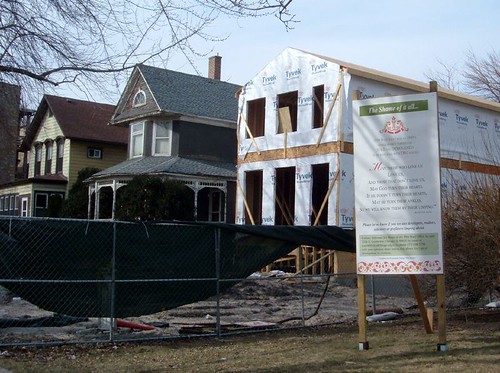
I never saw what was here before; it was gone by mid-2005 when I first saw the sign. Whatever it was, it was nice enough to inspire this protest from the neighbors:
The shame of it all...
1830 West Lunt was an 1890s single family farmhouse SOLD and DEMOLISHED to be replaced with TWO houses
"May those who love us, love us
And those that don't love us, may God turn their hearts.
If he doesn't turn their hearts, may he turn their ankles,
so we will know them by their limping." -- an old Irish saying
Pleaes let us know if you see any developers, realtors, solicitors, or profiteers limping about.
Contact Alderman Joe Moore at the 49th Ward Office...with your opinions about zoning that allows this type of development to continue.
Neighbors for Responsible Zoning ("The Zoners")

The new houses aren't much to write home about, at least from the outside. They've got stagefront brick facades, with vinyl siding behind (because no one can see the side of the house. It's invisible, don'tchaknow.) Why brick? I don't know!! None of the houses around them have brick. I guess brick automatically equates to "quality", and who can argue with quality?
They're not out of scale with the neighborhood or anything; in fact they're a bit too small to stand comfortably alongside the three-story older houses that surround them.
What makes the whole thing even more darkly hilarious is that the two new houses have sat empty for over two years now. One isn't even finished -- it only recently got its front porch, which still hasn't been painted. One of the houses finally sold a month or two back, and the builder's sign now reads "Only one left!" Yeah, better hurry there, folks.
The larger issue, of course, is how one should handle the eternal flux of city neighborhoods. This particular block is immensely valuable, because it's right next to a Metra stop. 20 minute access to downtown? That's an irresistible pull for developers. It's amazing this hasn't happened to the rest of the block.
Cities are always changing. Sometimes it happens slowly, in small bits and pieces like this. I don't always like the results, but I have my doubts about the alternatives. Can you really constrain a city, tell it where to grow and where not to? Should the city remain physically stagnant? Where should growth be allowed? At what point does a building have enough architectural and historical merit to be worth curbing that growth?
All are questions with no fixed answer, but as I see endless protests and complaints about the supposed scourge of condominiums (people with money are moving into the city?! OH NOEZ!!), I find myself wondering just what people do want to happen in their city. Should it remain the same forever?
3 comments:
I don't mind growth, what I mind is tearing down something gorgeous, structurally sound and much more sustainable over something so cheap and ugly looking. None of these houses go with the character of the neighborhood whatsoever. They always look out of place and probably indicate that the person living inside the home is out of place and an outsider as well. On the north side, there was a house next to an alley on Central Park that was 1950s or maybe 60s and very Frank Lloyd Wright-ish type of modern. Goregous home. Structurally sound. What happened? It was torn down to put up two of those ugly things and they just look completely out of place with the character of the neighborhood.
The brick is actually a building code thing -- "masonry" has been more or less required for several years now, which explains the ubiquity of those awful CMUs.
It's much more difficult to get people to provide positive, forward-thinking visions for their neighborhoods; much easier to reactionarily fight against any change. Such reaction is ultimately neither realistic nor fruitful, but it seems that we're cynics, conditioned to expect anything new to be awful and ill-conceived. It will take a lot of effort to get the populace to think otherwise.
Planners are supposed to take future needs into account when crafting plans and when implementing said said plans (e.g., via zoning), but like many places, Chicago doesn't do such "forward planning." We even rewrote the zoning without creating a plan for what the new zoning would do.
Honestly, I think the reactionary hatred against "Modern" styles is responsible for much of the quasi-traditional drek that gets slopped up today, and the according fear of anything new (well, that and the auto-centric overscaled crap that gets vomited out along suburban arterial routes.) Most architects can design something in a Modern vein that's at least nice, and possibly mind-blowingly awesome, but clients, neighbors and developers just aren't prone to giving them a chance. It's a shame, because we're no longer mass-producing buildings that reflect the spirit of our own time.
Post a Comment